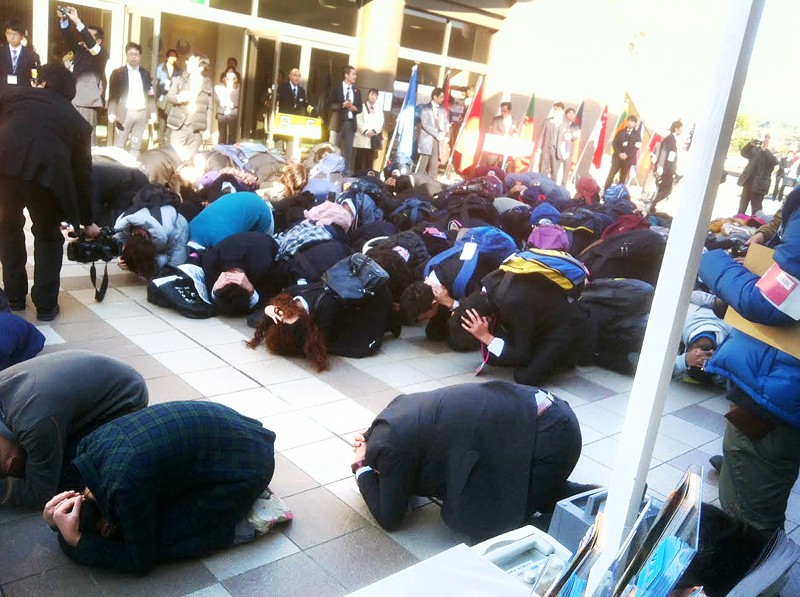Popular Reads
Top Results
Can't find what you're looking for?
View all search resultsPopular Reads
Top Results
Can't find what you're looking for?
View all search resultsAceh students join tsunami-awareness campaign in Japan
Change text size
Gift Premium Articles
to Anyone
O
ver the weekend, the town of Kuroshio played host to a gathering of 247 high schools from 30 countries including Indonesia, China, Greece and the United States, who participated in multiple events aimed at sharing best practices on dealing with tsunamis.
It was fitting that the worldwide United Nations-sponsored tsunami awareness campaign kicked off in Kuroshio, a scenic town in Kochi prefecture, in the southwest of Japan.
With rolling hills and seaside views from which local tourists can watch Pacific blue whales swim by, this unassuming Japanese town could be the safest place in the country, if not for the local authorities’ dire predictions for Kuroshio.
An official prediction said the town was highly tsunami-prone and could expect waves as high as 34 meters if a tsunami were to occur, causing severe damage.
Appropriately, the town has played a historic role in raising tsunami awareness. On the edge of Kuroshio stands the Ansei Tsunami Monument, which is a tribute to a tsunami that struck in 1854, causing severe damage to Kuroshio and other parts of Japan. The impact of the disaster led to the establishment of World Tsunami Awareness Day.
During the two-day gathering, participating students presented summaries of policies and efforts undertaken by their governments for tsunami preparedness and assessed what could be improved.
Tyler Trenten Keulakopono Kuanoni from Hilo High School in Hawaii, US, said Hawaii had a long history of earthquakes and tsunamis, but people there had differing attitudes toward natural disaster depending on their generation.
“Older people, who experienced the tsunami in the 1960s, knew about the tsunami but they are more casual about it now. Whereas the younger generation, they know about the danger but could not understand the potential danger,” Kuanoni said during a discussion on Saturday. Kuanoni was referring to the tsunami caused by an earthquake off the coast of Chile, which travelled across the Pacific Ocean and killed 61 people in Hilo.
Edo Prayoga from SMA 1 Peukan Bada senior high school in Banda Aceh, who represented Indonesia in the meeting said Aceh had paid a heavy price for its community’s lack of preparedness in dealing with tsunamis and that Acehnese today were motivated to tell the world about that cost from their experiences.
SMA 1 Peukan Bada lost more than 300 students during the Indian Ocean earthquake and tsunami that swept away most parts of Banda Aceh on Dec. 26, 2004. The school was located only 2.5 kilometers from the shore.
“Now we have a tsunami museum in Aceh to remind the world about the disaster,” Edo told members of other delegations in the meeting.
Fellow student Oktania Diya, who was 3 years old when the Aceh tsunami hit, said she was attending the conference to learn more about tsunami preparedness especially from her Japanese counterparts.
“I was lucky to survive the tsunami and I want to learn from Japan on how to deal with tsunamis if it happens again in the future,” said Oktania, who traveled with 15 fellow students from Aceh and her teacher Aminah Daud to join the conference.
Oktania got firsthand knowledge on how the Japanese prepared themselves to cope with such a disaster on Saturday. She joined locals in Kuroshio in a tsunami evacuation drill, which instructed participants to lay on the ground and then to run up a nearby hill, where after reaching the top they could shout at the sea, telling it how majestic it was.
The shouting bit was Hirofumi Maeda’s idea, the principal of Kuroshio High School, who decided to come up with a new preparedness procedure following the massive earthquake and tsunami of 2011 that devastated the eastern part of Japan, and killed more than 15,000 people.
“After the great earthquake [of 2011], we began conducting the evacuation drill on a weekly basis, where I always check the time it takes for them to run up the hill, to the evacuation point,” Maeda told participants of the summit who joined the drill on a bright, chilly weekend in Kuroshio.
“A tsunami is a scary natural disaster. It is frightening but nature is also beautiful. Should I deny my children this beauty,” Maeda said.










